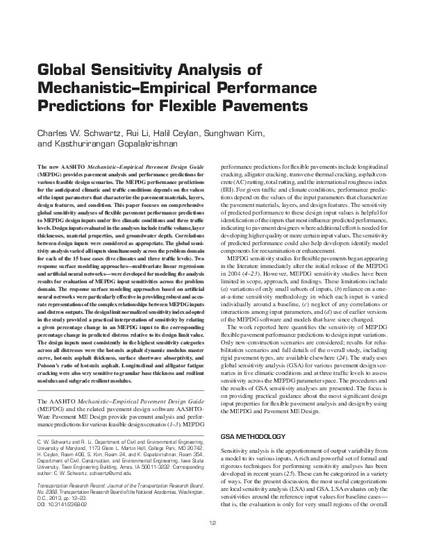
The new AASHTO Mechanistic–Empirical Pavement Design Guide (MEPDG) provides pavement analysis and performance predictions for various feasible design scenarios. The MEPDG performance predictions for the anticipated climatic and traffic conditions depends on the values of the input parameters that characterize the pavement materials, layers, design features, and condition. This paper focuses on comprehensive global sensitivity analyses of flexible pavement performance predictions to MEPDG design inputs under five climatic conditions and three traffic levels. Design inputs evaluated in the analyses include traffic volume, layer thicknesses, material properties, and groundwater depth. Correlations between design inputs were considered as appropriate. The global sensitivity analysis varied all inputs simultaneously across the problem domain for each of the 15 base cases (five climates and three traffic levels). Two response surface modeling approaches—multivariate linear regressions and artificial neural networks—were developed for modeling the analysis results for evaluation of MEPDG input sensitivities across the problem domain. The response surface modeling approaches based on artificial neural networks were particularly effective in providing robust and accurate representations of the complex relationships between MEPDG inputs and distress outputs. The design limit normalized sensitivity index adopted in the study provided a practical interpretation of sensitivity by relating a given percentage change in an MEPDG input to the corresponding percentage change in predicted distress relative to its design limit value. The design inputs most consistently in the highest sensitivity categories across all distresses were the hot-mix asphalt dynamic modulus master curve, hot-mix asphalt thickness, surface shortwave absorptivity, and Poisson’s ratio of hot-mix asphalt. Longitudinal and alligator fatigue cracking were also very sensitive to granular base thickness and resilient modulus and subgrade resilient modulus.
Available at: http://works.bepress.com/halil_ceylan/271/

This article is from Transportation Research Record: Journal of the Transportation Research Board , 2368 ( 2013): 12-23, doi: 10.3141/2368-02